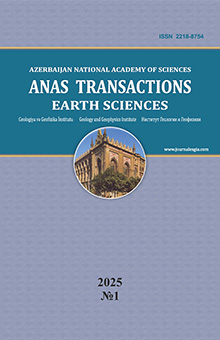№ 1,
2019
Download the article
Isotope-geochemical characteristics of hydrocarbons on the north-western flank of South Caspian basin
Geology and Geophysics Institute, Azerbaijan National Academy of Sciences, Javid Ave., 119, Baku, Azerbaijan, AZ1143: fakper@gmail.com
Summary
A-
A+
This paper details aspects of isotope-geochemical features for oil and gas on the N-W flank of South Caspian basin (Gobustan, western Absheron regions and adjacent offshore area), where natural oil and gas seepages are associated with tectonic faults and mud volcanoes (MVs). Oils concerned with MVs are biodegraded, having predominantly naphthenic-paraffinic base and less than 0.5% sulfur content. Oil samples and hydrocarbon extracts of source rock were analyzed using gas chromatography, mass spectrometry and their combination (biomarker analysis). Oil–oil and oil–source rock correlations are used. The values of the complex biomarker parameters of selected oil samples correspond to Tertiary source rocks with the similar organic facies accumulated in deep-water conditions with some terrestrial contribution. Oils have low to moderate organic maturities (Ro = 0.75-0.85). Relationship between the isotope composition of carbon (ICC) for aliphatic and aromatic fractions of oils and rock extracts (oil-rock correlation) shows that the source of commercial oil reserves in the Productive series (lower Pliocene) is mainly Miocene deposits (Diatom, Chokrak and Upper Maykop strata). The source of gases is from the sedimentary cover as is evidenced by the 3He/4He ratio values. They also have been derived from mixed marine organic-rich source facies. Such gas is not from the thermal destruction of oils. Calculated depth of oil source corresponds to 6.1-8.6 km (gas source – from 8.1 to 15.8 km). The isotopically heavy ICC of СО2 in gases is most probably the microbial destruction of hydrocarbons at shallow depths (no deeper than 2 km).
Keywords: oil, gas, source rocks, organic matter, geochemistry, correlation, South Caspian basin
REFERENCES
Faber E. About isotopic geochemistry of gaseous hydrocarbons. Erdol, Erdgas, Kohle, V. 103, Iss. 5, 1987, pp. 210-218 (in German).
Feyzullayev A.A. Mud volcanoes in the South Caspian basin: nature and estimated depth of its products. Natural Science, V. 4, № 7, 2012, pp. 445-453.
Feyzullayev A.A. Physicochemical interactions in the sedimentary rock – fluid system in the South Caspian basin in connection with oil-gas ontogenesis. Proceedings of ANAS, The Sciences of Earth, № 4, 2010, pp. 28-45 (in Russian).
Feyzullayev A.A., Aliyeva Es.A. Estimation of the various source rocks contribution in oil pools formation. Proceedings of EAGE 65 Conference and Exhibition. Stavanger. Norway, 2-5 June, 2003.
Feyzullayev A.A., Movsumova U.A. The nature of the isotopically heavy carbon composition of carbon dioxide and bicarbonates in the waters of mud volcanoes in Azerbaijan. Geochemistry International, V. 48, № 5, 2010, pp. 517-522.
Feyzullayev A.A., Tagiyev M.F., Lerche I. On the origin of hydrocarbons in the main Lower Pliocene reservoirs of the South Caspian Basin, Azerbaijan. Energy, Exploration & Exploitation, V. 33, № 1, 2015, pp. 1-14.
Galimov E.M. Carbon isotopes in oil and gas geology. Nedra. Moscow, 1973, 384 p. (in Russian).
Guliyev I.S., Feyzullayev A.A., Huseynov D.A. Geochemical features and source of fluids of mud volcanoes in South Caspian basin in lights of new data at isotopes С, Н, and О. Geochimiya, № 7, 2004, 792-800 (in Russian).
Irwin H., Curtis C., Coleman M. Isotopic evidence for source of diagenetic carbonates formed during burial of organic rich sediments. Nature, V. 269, Iss. 5625, 1977, pp. 209-213.
Kissin I.G., Pakhomov S.N. On the possibility of generation of hydrocarbonic acid in the interiors under moderately high temperatures. Doklаdy AS of the USSR, V. 174, № 2, 1967, pp. 451-454 (in Russian).
Marzi R., Torkelson, B.E., Olson R.K. A revised carbon preference index. Organic Geochemistry, V. 20, № 8, 1993, pp. 1303-1306.
Pallasser R.J. Recognising biodegradation in gas/oil accumulations through the 13C compositions of gas components. Org. Geochem., V. 31, № 12, 2000, pp. 1363-1373.
Peters K.E., Moldowan J.M. The biomarker guide: interpreting molecular fossils in petroleum and ancient sediments. Prentice Hall. Englewood Cliffs, New Jersey, 1993, 363 p.
Valyaev B.M., Grinchenko Yu.I. Source of isotopically “ultra-heavy” carbon dioxide in natural gases. In: Proceedings of 10th All Union symposium on Stable Isotopes in Geochemistry, Moscow, Russia, 1984, p. 170 (in Russian).
Wilhelms A., Larter S.R., Head I. et al. Biodegradation of oil in uplifted basins prevented by deep burial sterilization. Nature, V. 411, 2001, pp. 1034-1037.
Zartman R.E., Wasserburg G.J., Reynolds J.H. Helium, argon and carbon in some natural gases. J. Geophys. Res., V. 66, 1961, pp. 277-286.
DOI:
10.33677/ggianas20190100021
